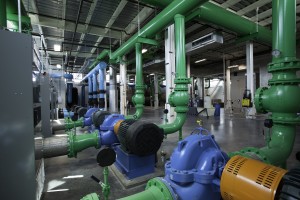 Many of us felt the effects of unexpected power outages during this recent brutal winter and the polar vortex that pummeled most of the country. For most of us, energy disruptions are a moderate inconvenience, but such an inconvenience can turn into a major crisis for critical infrastructure facilities. On-site power generation is often an ideal solution to meet power supply requirements during disasters.
Many of us felt the effects of unexpected power outages during this recent brutal winter and the polar vortex that pummeled most of the country. For most of us, energy disruptions are a moderate inconvenience, but such an inconvenience can turn into a major crisis for critical infrastructure facilities. On-site power generation is often an ideal solution to meet power supply requirements during disasters.
In the wake of Superstorm Sandy, when extended power outages affected parts of the Northeast U.S. for days, more owners and operators turned to on-site energy, recognizing the benefits it provides. On-site energy systems not only improve the resiliency and reliability of their own systems, but also take loads away from the grid.
Owners with on-site energy generation, like combined heat and power (CHP) systems, are able to disconnect from the electric grid and become energy self-sufficient, minimizing the negative effects of grid outages and allowing operations to continue normally.
Hospitals are perfect candidates for on-site energy systems, with consistent 24/7 load demand for electricity, heating and cooling. The Shands Cancer Hospital in Gainesville, Fla., for example, sits in a hurricane zone. The hospital’s CHP system was designed to run parallel with the electric utility grid and provide efficient and reliable electric power, chilled water, steam and medical gases. If a natural disaster or unplanned event causes the grid to fail, the system can disconnect and run in island mode to meet 100 percent of the hospital’s needs for an extended period.
The Department of Energy has advocated for use of on-site energy systems as a means for helping achieve short-term reductions in energy use, not just for hospitals and other institutions, but also for municipalities, manufacturers, commercial buildings and residential areas.
The U.S. Energy Information Administration regularly updates its website with weather-related events that have the potential to affect U.S. energy infrastructure. The widespread effects of recent winter storms are amazing, and so many utilities now have to revisit their planning and infrastructure needs. A report I read recently said one winter storm this year knocked out so much power in Southeastern Pennsylvania, it was second only to Superstorm Sandy in terms of power disruptions for the region. As we see more owners move toward on-site energy, it’s likely the strain on the grid during natural disasters will be reduced.
As you might have guessed, on-site energy is something I’m passionate about; I’m lucky to work with an equally passionate team. If you’re interested in learning more about on-site power and whether your facility might be a good candidate, connect with me on LinkedIn.
Tim Burkhalter is a business development manager in Burns & McDonnell’s OnSite Energy & Power Group. He specializes in campus energy systems and helping clients develop energy reduction and efficiency strategies.
